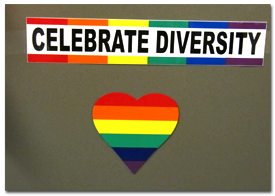Diversity Issues
Sexual Minorities/GLBTTTIQQ
“How does one become a butterfly?” she asked pensively. “You must want to fly so much that you are willing to give up being a caterpillar.”
 The traditional world view of Western society has been that there were only two categories of sex (male, female) and gender (man, woman) and that men and women were expected to look and behave in particular ways. Anyone who did not fit in either of the two categories faced rejection, discrimination, isolation, and possible violence. While this world view is slowly changing, people who do not fit into society’s stereotypes still face risk of discrimination and violence. Rigid beliefs about sex and gender cloud the reality of our own diversity.
The traditional world view of Western society has been that there were only two categories of sex (male, female) and gender (man, woman) and that men and women were expected to look and behave in particular ways. Anyone who did not fit in either of the two categories faced rejection, discrimination, isolation, and possible violence. While this world view is slowly changing, people who do not fit into society’s stereotypes still face risk of discrimination and violence. Rigid beliefs about sex and gender cloud the reality of our own diversity.
I desire a person, not a gender.
 Human sexuality involves of four components: sex, gender identity, gender role behaviour or expression, and sexual orientation. Recent conceptual models describe each of the components as being on a continuum, with a range of possibilities, rather than there being only two possibilities (polar opposites = stereotyped categories). As our beliefs have changed over the years, we have been able to move from stigma to pride, from phobia to positivity, and from dualism to diversity.
Human sexuality involves of four components: sex, gender identity, gender role behaviour or expression, and sexual orientation. Recent conceptual models describe each of the components as being on a continuum, with a range of possibilities, rather than there being only two possibilities (polar opposites = stereotyped categories). As our beliefs have changed over the years, we have been able to move from stigma to pride, from phobia to positivity, and from dualism to diversity.
I offer specialized services to those who identify as:

- Gay
- Lesbian
- Bisexual
- Transgendered
- Transsexual
- Two-spirited
- Cross-dresser
- Intersex
- Queer
- Questioning (their gender identity and/or sexual orientation).
It is better to be hated for what one is than to be loved for what one isn’t.
I am a gender specialist and I serve as a transition guide. I also focus on the concerns and issues relevant to all who identify as being a member of a sexual minority. Common concerns or issues may include any of the following:
- Coming out/disclosure to others
- Internalized homophobia or transphobia.
- Gender or sexual identity development issues
- Accessing health care
- Relationships
- Domestic violence
- Discrimination
- Body image issues
- Mental health issues related to HIV-Positive/AIDS
- Managing heterosexism
- Safe sex
- Support systems, needs, resources.
While many minority groups are the target for prejudice…and discrimination…in our society, few persons face this hostility without the support and acceptance of their family as do many gay, lesbian and bisexual youth.
